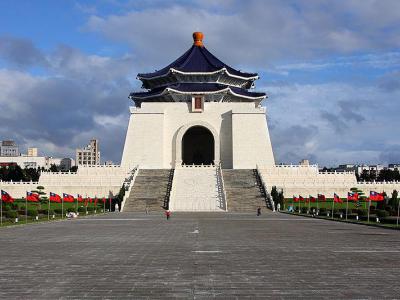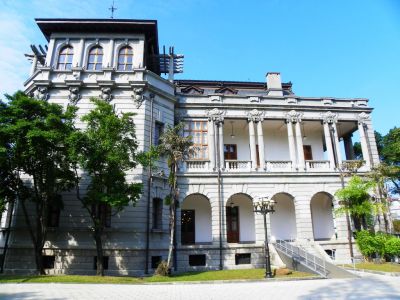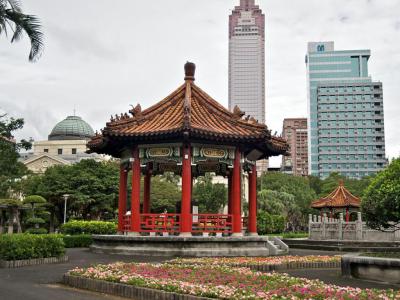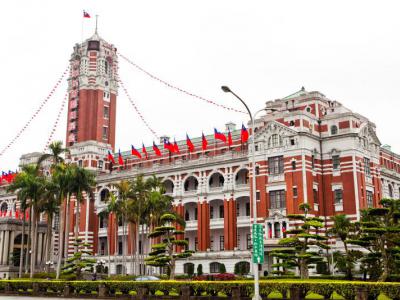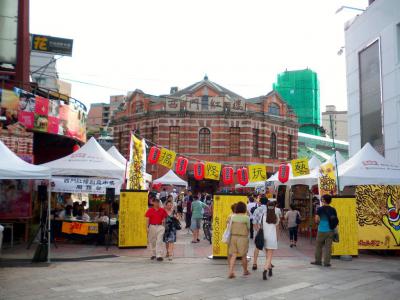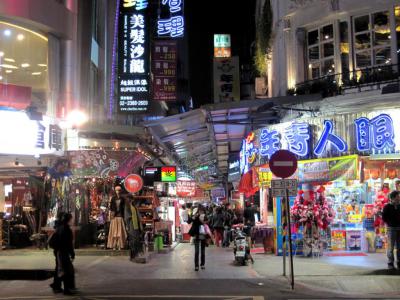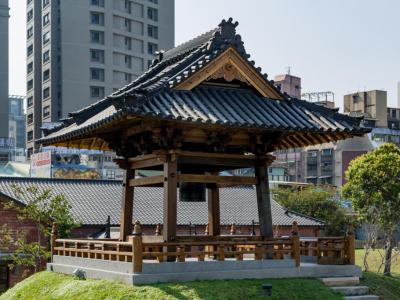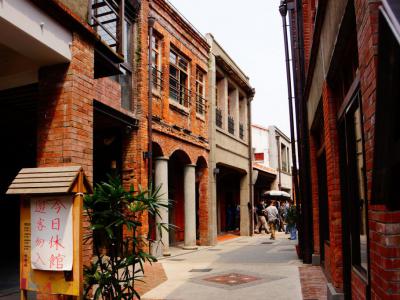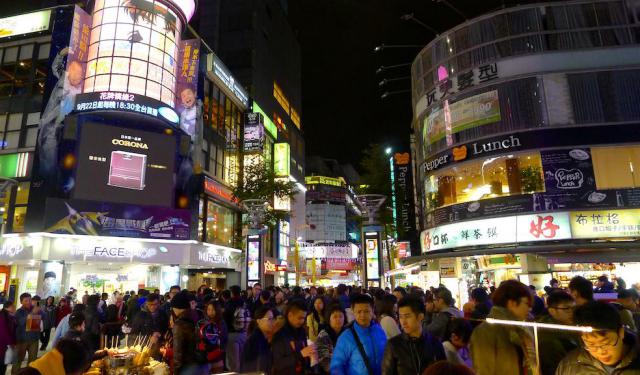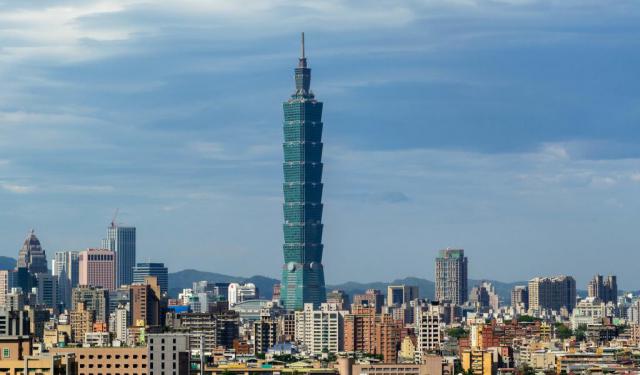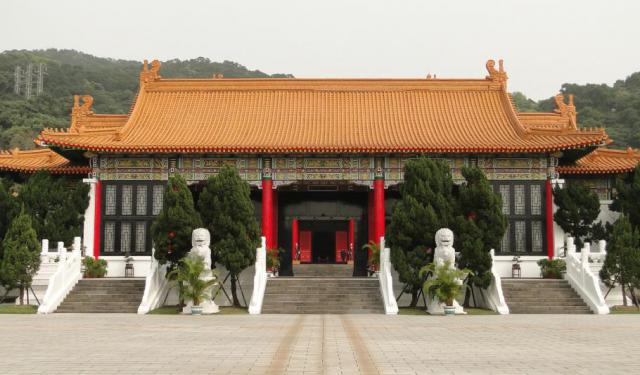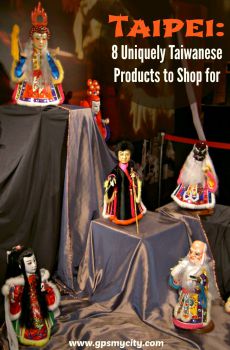Taipei Introduction Walking Tour (Self Guided), Taipei
Taipei is the political, economic, educational and cultural center of Taiwan, with a population of 2.5 million. The region of Taipei had been mainly inhabited by the Ketagalan tribe prior to the large influx of mainland Chinese immigrants in the 17th century.
Under the Qing Dynasty of China, Taipei was made the capital of Taiwan in 1887 when the island was incorporated into a Chinese province. Following the first Sino-Japanese War of 1895, Taiwan was annexed by Japan. The Japanese colonized the island until 1945, when it was returned to China after the World War II.
Taipei is a home to various architectural and cultural landmarks, such as Taipei 101, Chiang Kai-shek Memorial Hall, Longshan Temple, Presidential Office Building, Taipei Guest House, Ximending and several night markets dispersed throughout the city.
Liberty Square is the political and cultural center of the city. At its east end stands the National Chiang Kai-shek Memorial Hall, which is flanked by the National Concert Hall on the north and the National Theater on the south. The square is a place for public gatherings, as well as a home to civic parks.
Presidential Office Building and Taipei Guest House are the two historical buildings constructed during the Japanese colonial period. Designed by Japanese architects, both buildings feature a Baroque style that clearly takes inspiration from the classical European architecture.
No visit to Taipei is complete without a trip to one of its night markets. At the Ximending Night Market you will find hundreds of stalls selling clothes, accessories, makeup products, and traditional Taiwanese snacks. The latter are particularly tempting while watching an array of shows by the local street performers – an experience not to be forgotten for a long time!
Taipei is a fascinating place which blends seamlessly ancient Chinese traditions with modern trends. Follow this self-guided walking tour to see the key landmarks of Taipei and appreciate the city's vibrant culture in its entirety.
Under the Qing Dynasty of China, Taipei was made the capital of Taiwan in 1887 when the island was incorporated into a Chinese province. Following the first Sino-Japanese War of 1895, Taiwan was annexed by Japan. The Japanese colonized the island until 1945, when it was returned to China after the World War II.
Taipei is a home to various architectural and cultural landmarks, such as Taipei 101, Chiang Kai-shek Memorial Hall, Longshan Temple, Presidential Office Building, Taipei Guest House, Ximending and several night markets dispersed throughout the city.
Liberty Square is the political and cultural center of the city. At its east end stands the National Chiang Kai-shek Memorial Hall, which is flanked by the National Concert Hall on the north and the National Theater on the south. The square is a place for public gatherings, as well as a home to civic parks.
Presidential Office Building and Taipei Guest House are the two historical buildings constructed during the Japanese colonial period. Designed by Japanese architects, both buildings feature a Baroque style that clearly takes inspiration from the classical European architecture.
No visit to Taipei is complete without a trip to one of its night markets. At the Ximending Night Market you will find hundreds of stalls selling clothes, accessories, makeup products, and traditional Taiwanese snacks. The latter are particularly tempting while watching an array of shows by the local street performers – an experience not to be forgotten for a long time!
Taipei is a fascinating place which blends seamlessly ancient Chinese traditions with modern trends. Follow this self-guided walking tour to see the key landmarks of Taipei and appreciate the city's vibrant culture in its entirety.
How it works: Download the app "GPSmyCity: Walks in 1K+ Cities" from Apple App Store or Google Play Store to your mobile phone or tablet. The app turns your mobile device into a personal tour guide and its built-in GPS navigation functions guide you from one tour stop to next. The app works offline, so no data plan is needed when traveling abroad.
Taipei Introduction Walking Tour Map
Guide Name: Taipei Introduction Walking Tour
Guide Location: Taiwan » Taipei (See other walking tours in Taipei)
Guide Type: Self-guided Walking Tour (Sightseeing)
# of Attractions: 10
Tour Duration: 2 Hour(s)
Travel Distance: 3.6 Km or 2.2 Miles
Author: irenebo
Sight(s) Featured in This Guide:
Guide Location: Taiwan » Taipei (See other walking tours in Taipei)
Guide Type: Self-guided Walking Tour (Sightseeing)
# of Attractions: 10
Tour Duration: 2 Hour(s)
Travel Distance: 3.6 Km or 2.2 Miles
Author: irenebo
Sight(s) Featured in This Guide:
- Chiang Kai-shek Memorial Hall
- Liberty Square
- Taipei Guest House
- 228 Peace Memorial Park
- Presidential Office Building
- Ximending District and Red House Theater
- Ximending Night Market
- Nishi Honganji Square
- Bopiliao Old Street
- Longshan Temple
1) Chiang Kai-shek Memorial Hall (must see)
The Chiang Kai-shek Memorial Hall is a well-known national monument and tourist attraction situated in remembrance of Generalissimo Chiang Kai-shek, the former President of the Republic of China. It is located on the eastern side of Taipei's Liberty Square and is flanked by the National Theater and National Concert Hall to the north and south, respectively.
This memorial hall is characterized by its white color and four-sided structure, featuring a blue octagonal roof, which symbolically represents the number eight. In Asian culture, the number eight is traditionally associated with abundance and good fortune. To reach the main entrance, there are two sets of white stairs, each comprising 89 steps, symbolizing Chiang's age at the time of his passing.
Inside the memorial, the ground level accommodates a library and a museum dedicated to documenting Chiang Kai-shek's life and career. Additionally, there are exhibits that delve into Taiwan's history and development. The upper level houses the main hall, where a prominent statue of Chiang Kai-shek is situated. Periodically, a guard mounting ceremony takes place within this hall.
Why You Should Visit:
The architecture is incredibly unique and views of the square are excellent from top of the Hall's stairs.
The Hall is also flanked by the National Theater & Concert Hall, which are good places to stop for lunch, tea, or gift shopping.
Tip:
The Military Honor Guard changes every hour, on the hour, from 9am to 5pm. Get there 10-15 mins early – it often draws a big crowd. Afterward, you may browse the garden downstairs or museum with its multiple exhibits.
Key tip for best viewing of the changing of the guard ceremony: If facing the statue, stand on the very right side closest to the elevator entrance. There you will see – and be able to take photos of – the new guards coming out, the entire ceremony unobstructed, and then the old guards exiting.
This memorial hall is characterized by its white color and four-sided structure, featuring a blue octagonal roof, which symbolically represents the number eight. In Asian culture, the number eight is traditionally associated with abundance and good fortune. To reach the main entrance, there are two sets of white stairs, each comprising 89 steps, symbolizing Chiang's age at the time of his passing.
Inside the memorial, the ground level accommodates a library and a museum dedicated to documenting Chiang Kai-shek's life and career. Additionally, there are exhibits that delve into Taiwan's history and development. The upper level houses the main hall, where a prominent statue of Chiang Kai-shek is situated. Periodically, a guard mounting ceremony takes place within this hall.
Why You Should Visit:
The architecture is incredibly unique and views of the square are excellent from top of the Hall's stairs.
The Hall is also flanked by the National Theater & Concert Hall, which are good places to stop for lunch, tea, or gift shopping.
Tip:
The Military Honor Guard changes every hour, on the hour, from 9am to 5pm. Get there 10-15 mins early – it often draws a big crowd. Afterward, you may browse the garden downstairs or museum with its multiple exhibits.
Key tip for best viewing of the changing of the guard ceremony: If facing the statue, stand on the very right side closest to the elevator entrance. There you will see – and be able to take photos of – the new guards coming out, the entire ceremony unobstructed, and then the old guards exiting.
2) Liberty Square
Liberty Square, also known as Freedom Square, is a prominent public space in Taipei. It serves as a significant gathering place for the public and is home to three important landmarks, as well as civic parks. Positioned at the eastern end of Liberty Square is the National Chiang Kai-shek Memorial Hall. On the square's northern side stands the National Concert Hall, while the National Theater graces its southern side. The square is surrounded by a park, and the entire site is enclosed by a wall.
Liberty Square frequently hosts large gatherings in Taiwan and is often used for grand events, including red-carpet ceremonies where the Taiwanese president welcomes foreign dignitaries. The square sees a continuous influx of crowds throughout the year, drawn by outdoor festivals and concerts. The Taipei Lantern Festival is a regular occurrence on the square. On many days, you can observe students, athletes, and soldiers at the square, engaging in drills and dance routines. The National Theater and Concert Hall, located adjacent to the square, collectively host over 800 events each year and serve as iconic backdrops for square events.
The ponds and parks surrounding the memorial and cultural centers are beautifully landscaped with well-maintained lawns, trees, and pathways. The ponds are inhabited by colorful koi fish, a common feature in East Asian gardens. These parks are often used for quieter forms of public activities, such as games of Go, taekwondo, Tai Chi, and other martial arts practices. Additionally, the grounds are utilized for holiday marching band performances, drum and bugle corps concerts, honor guard drill shows, and traditional Chinese dances.
Liberty Square frequently hosts large gatherings in Taiwan and is often used for grand events, including red-carpet ceremonies where the Taiwanese president welcomes foreign dignitaries. The square sees a continuous influx of crowds throughout the year, drawn by outdoor festivals and concerts. The Taipei Lantern Festival is a regular occurrence on the square. On many days, you can observe students, athletes, and soldiers at the square, engaging in drills and dance routines. The National Theater and Concert Hall, located adjacent to the square, collectively host over 800 events each year and serve as iconic backdrops for square events.
The ponds and parks surrounding the memorial and cultural centers are beautifully landscaped with well-maintained lawns, trees, and pathways. The ponds are inhabited by colorful koi fish, a common feature in East Asian gardens. These parks are often used for quieter forms of public activities, such as games of Go, taekwondo, Tai Chi, and other martial arts practices. Additionally, the grounds are utilized for holiday marching band performances, drum and bugle corps concerts, honor guard drill shows, and traditional Chinese dances.
3) Taipei Guest House
The Taipei Guest House is a historic structure located on Ketagalan Boulevard in the Zhongzheng District of Taipei. It is owned by the Government of the Republic of China and serves as a place for hosting state guests and hosting celebratory events. This architectural masterpiece was designed by Japanese architects Dōgo Fukuda and Ichiro Nomura and was constructed between 1899 and 1901. It was later renovated by Matsunosuke Moriyama in 1911.
During the Japanese colonial period, from its construction until 1920, the Taipei Guest House served as the residence of the Governor-General of Taiwan. It was strategically positioned approximately 100 meters away from the Office of the Governor-General of Taiwan, which is now known as the Presidential Building. It was a notable destination for imperial figures and political leaders. Even Emperor Showa (Crown Prince Hirohito) visited and stayed at this place when he visited Taiwan.
After Taiwan was transferred to the Republic of China, the Treaty of Taipei was signed here in 1952 by ROC Minister of Foreign Affairs George Yeh and Japanese Minister of Foreign Affairs Isao Kawada.
The building itself features a distinctive concave shape with a Mansard-style roof and tall Roman pillars, reminiscent of French Second Empire palace architecture. Inside, the building boasts a stunning crystal chandelier adorned with baroque gold leaves, flowers, and gold foil. Outside, there is a modern Japanese garden.
The Taipei Guest House is considered a significant representation of architectural heritage from the Japanese colonial era in Taiwan and is often referred to as the most elegant Baroque-style residence in the region.
Since June 4, 2006, the Taipei Guest House has been open to the public on the first Sunday of every even-numbered month.
During the Japanese colonial period, from its construction until 1920, the Taipei Guest House served as the residence of the Governor-General of Taiwan. It was strategically positioned approximately 100 meters away from the Office of the Governor-General of Taiwan, which is now known as the Presidential Building. It was a notable destination for imperial figures and political leaders. Even Emperor Showa (Crown Prince Hirohito) visited and stayed at this place when he visited Taiwan.
After Taiwan was transferred to the Republic of China, the Treaty of Taipei was signed here in 1952 by ROC Minister of Foreign Affairs George Yeh and Japanese Minister of Foreign Affairs Isao Kawada.
The building itself features a distinctive concave shape with a Mansard-style roof and tall Roman pillars, reminiscent of French Second Empire palace architecture. Inside, the building boasts a stunning crystal chandelier adorned with baroque gold leaves, flowers, and gold foil. Outside, there is a modern Japanese garden.
The Taipei Guest House is considered a significant representation of architectural heritage from the Japanese colonial era in Taiwan and is often referred to as the most elegant Baroque-style residence in the region.
Since June 4, 2006, the Taipei Guest House has been open to the public on the first Sunday of every even-numbered month.
4) 228 Peace Memorial Park
228 Peace Memorial Park is a municipal park in Taipei that is also a famous historic site. This park commemorates the victims of the February 28 incident in 1947. The monument at the park's center, designed by Cheng Tzu-Tsai, has an inscription that calls for peace and unity, an inscription with a statement from The 228 Peace Memorial Monument Preparatory Committee, and Micah 4:3-4.
The Taipei 228 Memorial Museum is at the site where the radio station once stood where the February 28 Incident occurred. Visitors can learn more about the history behind the incident and Taipei overall.
One of the things that stands out about this park is its tranquil setting, with a lot of green space. You'll be able to enjoy a leisurely walk around the area, as well as enjoy the chance to sit and enjoy the scenery. The tranquil setting is worth your time.
The Taipei 228 Memorial Museum is at the site where the radio station once stood where the February 28 Incident occurred. Visitors can learn more about the history behind the incident and Taipei overall.
One of the things that stands out about this park is its tranquil setting, with a lot of green space. You'll be able to enjoy a leisurely walk around the area, as well as enjoy the chance to sit and enjoy the scenery. The tranquil setting is worth your time.
5) Presidential Office Building
The Presidential Office Building was constructed during Japanese rule in Taiwan, bombed by the Allies during World War II, and rebuilt. The building features a Baroque style. The building has been the seat of the Republic of China's government and Presidential workplace since 1950. Today, this building enjoys status as a major historical landmark in the city of Taipei.
The entrance area has a relatively simple design. A marble grand staircase and porch featuring Corinthian and Ionic pillars help create an impressive reception area for visitors, as well as dignitaries who come here on official business. The Ching-Kuo Hall is the building's primary location for receptions, including visits from heads of state and presidential inaugurations.
An important historical document on display is the Japanese Instrument of Surrender, drafted after World War II. This building also has an internal courtyard that is worth a look at. Features present in this courtyard include gardens and a covered walkway.
Tip:
To take a free tour (circa 60-90 mins), go around to the side entrance and line up to go through security check first (passport/bags). Once inside, be sure to ask politely if you are allowed taking photos in some areas (video strictly forbidden anywhere). At the end, there's a nice small gift shop full of souvenirs and a spot where you can buy specialty stamps.
The entrance area has a relatively simple design. A marble grand staircase and porch featuring Corinthian and Ionic pillars help create an impressive reception area for visitors, as well as dignitaries who come here on official business. The Ching-Kuo Hall is the building's primary location for receptions, including visits from heads of state and presidential inaugurations.
An important historical document on display is the Japanese Instrument of Surrender, drafted after World War II. This building also has an internal courtyard that is worth a look at. Features present in this courtyard include gardens and a covered walkway.
Tip:
To take a free tour (circa 60-90 mins), go around to the side entrance and line up to go through security check first (passport/bags). Once inside, be sure to ask politely if you are allowed taking photos in some areas (video strictly forbidden anywhere). At the end, there's a nice small gift shop full of souvenirs and a spot where you can buy specialty stamps.
6) Ximending District and Red House Theater (must see)
The Ximending District is Taiwan's first pedestrian zone. In addition to being home to a large collection of stores, the district also attracts street vendors. As many as three million shoppers visit this area every month. Some of the larger stores represented in this area include Shizilin Square and Wannien Department Store.
One of the focal points in the Ximending District is the Red House Theater. This building dates back to 1908 when Tapei was under Japanese rule and originally served as a market building. This theater consists of an octagonal building for theatrical performances, along with a cafe and display showcasing the building's history and a cruciform-shaped building that hosts shops.
There is a square in front of the Red House Theater that has served as the location for the Lantern Festival in the past. You might even be lucky to see a celebrity performing an unannounced concert in the square area. The area immediately behind the theater is host to a number of bars that contribute to much of the city's nightlife.
One of the focal points in the Ximending District is the Red House Theater. This building dates back to 1908 when Tapei was under Japanese rule and originally served as a market building. This theater consists of an octagonal building for theatrical performances, along with a cafe and display showcasing the building's history and a cruciform-shaped building that hosts shops.
There is a square in front of the Red House Theater that has served as the location for the Lantern Festival in the past. You might even be lucky to see a celebrity performing an unannounced concert in the square area. The area immediately behind the theater is host to a number of bars that contribute to much of the city's nightlife.
7) Ximending Night Market
The Ximending Night Market is not just for night owls. This market is a great place to go shopping, try various types of food and go for an enjoyable walk in a safe space.
This market is a favorite among visitors because it is clean and has plenty of space. The street is closed to traffic, which contributes to the open nature of the market. Along with multiple restaurants, the market sees regular street performers who provide endless entertainment.
Though there are many night markets in Taipei, Ximending Night Market is unique because the neighborhood's routes are embroiled with Taiwan's Japanese era. As such, much of the visible architecture has a distinct Japanese influence. Many of the food stalls also get their flavor from Japan.
Ximending Night Market is popular among youth thanks to many quirky and interesting shops. Those traveling with youngsters may find a claw machine shop or bubble tea cafes that sell fun and trendy drinks.
Ximending Night Market opens at 5 PM and closes promptly at 11 PM every night.
This market is a favorite among visitors because it is clean and has plenty of space. The street is closed to traffic, which contributes to the open nature of the market. Along with multiple restaurants, the market sees regular street performers who provide endless entertainment.
Though there are many night markets in Taipei, Ximending Night Market is unique because the neighborhood's routes are embroiled with Taiwan's Japanese era. As such, much of the visible architecture has a distinct Japanese influence. Many of the food stalls also get their flavor from Japan.
Ximending Night Market is popular among youth thanks to many quirky and interesting shops. Those traveling with youngsters may find a claw machine shop or bubble tea cafes that sell fun and trendy drinks.
Ximending Night Market opens at 5 PM and closes promptly at 11 PM every night.
8) Nishi Honganji Square
Nishi Honganji Square is a park that is on a site once home to a 19th century Japanese temple. The main temple building was destroyed by a fire in 1975. Part of the mausoleum and the head priest's living quarters were the only parts of the building left.
Visitors can access this area by climbing a small hillock. One of the highlights that visitors will notice as they approach the original temple site is a wooden bell tower. The Taipei City Archives are in a building next to the steps that led to the original temple, where visitors can see a map of the square and pick up English-language guide.
Today, the priest's quarters, known as the Rinbansyo, are a teahouse. The teahouse features Japanese-style architecture and has large windows that let in plenty of afternoon light. Enjoy Taiwanese tea and rice dishes in the seating area or at one of the tables and enjoy the relaxing setting.
Visitors can access this area by climbing a small hillock. One of the highlights that visitors will notice as they approach the original temple site is a wooden bell tower. The Taipei City Archives are in a building next to the steps that led to the original temple, where visitors can see a map of the square and pick up English-language guide.
Today, the priest's quarters, known as the Rinbansyo, are a teahouse. The teahouse features Japanese-style architecture and has large windows that let in plenty of afternoon light. Enjoy Taiwanese tea and rice dishes in the seating area or at one of the tables and enjoy the relaxing setting.
9) Bopiliao Old Street
Bopiliao Old Street is one of Taipei's oldest historic streets. One of the things that stand out for visitors is its collection of buildings over 100 years old. The brick buildings on this street have a distinctive style from other buildings in Taipei, making this area stand out for the buildings alone.
There are historical markers providing interesting information about each of the historical locations that you'll find on this street. Preserved buildings open to the public help provide an exciting look into history in the Japanese colonial period. One of the preserved buildings representative of this period contains a schoolroom.
There are exhibits located along the street that provide interesting information about the buildings. You might be able to browse through some herbalists' stalls, as well as catch a street band performing while you are in this area. Regardless of what catches your interest here, you're sure to enjoy the time spent.
There are historical markers providing interesting information about each of the historical locations that you'll find on this street. Preserved buildings open to the public help provide an exciting look into history in the Japanese colonial period. One of the preserved buildings representative of this period contains a schoolroom.
There are exhibits located along the street that provide interesting information about the buildings. You might be able to browse through some herbalists' stalls, as well as catch a street band performing while you are in this area. Regardless of what catches your interest here, you're sure to enjoy the time spent.
10) Longshan Temple (must see)
The Longshan Temple was originally constructed in 1738 and was a place for Chinese settlers to worship. Part of the original construction included Buddhist elements, as well as altars and halls dedicated to the Chinese deities Guan Yu and Mazu. This temple has seen rebuilding and renovations because of earthquakes and fires over the years.
The last rebuilding of the temple took place after World War II. Today, one of the most noteworthy attractions is the outer courtyard, which has unique elements that include Taoist symbols, along with Buddhist and Confucian symbols. The temple and courtyard boast an impressive display of color.
Carvings found throughout the temple and on the exterior are intricate, with a lot of detail. Dragons are famous figures found throughout the temple, and the temple's name translates to "dragon mountain". Buddha figures in gold are also quite popular.
Decorations are popular in the temple, especially during certain holidays. For example, during the Lunar New Year, you are likely to see a lot of lanterns. Flowers are usually in abundance throughout this building.
One of the altars that attract a lot of attention is the altar to Yue Lao, a god revered as being a matchmaker. Single Taipei residents often come to this altar to pray for their true love to go to them and remain with them forever. There are pieces of string that worshipers can take to tie around their true love's wrist when they find them.
Why You Should Visit:
The Longshan Temple is one of the oldest and most important temples in Taiwan.
Tip:
The temple can be quite full with tour groups during certain days so try to avoid peak hours. There are local food stalls around the temple and plenty of shops selling Buddhist merch in the nearby underground mall.
The last rebuilding of the temple took place after World War II. Today, one of the most noteworthy attractions is the outer courtyard, which has unique elements that include Taoist symbols, along with Buddhist and Confucian symbols. The temple and courtyard boast an impressive display of color.
Carvings found throughout the temple and on the exterior are intricate, with a lot of detail. Dragons are famous figures found throughout the temple, and the temple's name translates to "dragon mountain". Buddha figures in gold are also quite popular.
Decorations are popular in the temple, especially during certain holidays. For example, during the Lunar New Year, you are likely to see a lot of lanterns. Flowers are usually in abundance throughout this building.
One of the altars that attract a lot of attention is the altar to Yue Lao, a god revered as being a matchmaker. Single Taipei residents often come to this altar to pray for their true love to go to them and remain with them forever. There are pieces of string that worshipers can take to tie around their true love's wrist when they find them.
Why You Should Visit:
The Longshan Temple is one of the oldest and most important temples in Taiwan.
Tip:
The temple can be quite full with tour groups during certain days so try to avoid peak hours. There are local food stalls around the temple and plenty of shops selling Buddhist merch in the nearby underground mall.
Walking Tours in Taipei, Taiwan
Create Your Own Walk in Taipei
Creating your own self-guided walk in Taipei is easy and fun. Choose the city attractions that you want to see and a walk route map will be created just for you. You can even set your hotel as the start point of the walk.
Taipei Shopping Tour
Among the many things Taipei is famous for, shopping is undoubtedly one of the main. The fashion-conscious and business-oriented Taiwanese capital is rightfully regarded to be a shopper’s paradise in East Asia, comparable to the likes of Hong Kong, Seoul, Tokyo, Singapore or Kuala Lumpur. The variety of markets, boutique stores, shopping districts and, of course, first-class malls here is truly... view more
Tour Duration: 1 Hour(s)
Travel Distance: 1.9 Km or 1.2 Miles
Tour Duration: 1 Hour(s)
Travel Distance: 1.9 Km or 1.2 Miles
Taipei 101 and Xiangshan Walking Tour
The newest area of urban Taipei, the Xinyi district has technically existed only since 1990. Young as it is though, the neighborhood has earned a reputation of being one of the city's premier travel destinations.
Indeed, in Xinyi you’re never too far from experiencing something truly cool or iconic, be it the impressive Taipei 101 with its landmark observation deck or the breathtaking... view more
Tour Duration: 1 Hour(s)
Travel Distance: 2.3 Km or 1.4 Miles
Indeed, in Xinyi you’re never too far from experiencing something truly cool or iconic, be it the impressive Taipei 101 with its landmark observation deck or the breathtaking... view more
Tour Duration: 1 Hour(s)
Travel Distance: 2.3 Km or 1.4 Miles
Zhongshan District Walking Tour
Covering a swathe of central Taipei, Zhongshan is the city's most fascinating district. It takes the name from Sun Yat-sen, aka Sun Zhongshan, who was a Chinese statesman and went down in history as the provisional first president of the Republic of China in 1912. Caught in the crosshatch of the area's main streets and secret alleyways is a wonderful mish-mash of attractions: museums and... view more
Tour Duration: 2 Hour(s)
Travel Distance: 5.0 Km or 3.1 Miles
Tour Duration: 2 Hour(s)
Travel Distance: 5.0 Km or 3.1 Miles
Useful Travel Guides for Planning Your Trip
Taipei Souvenirs: 8 Uniquely Taiwanese Products to Bring Home
Other than being an affluent Chinese state off the shore of mainland China, a non-Chinese foreigner might not know much about Taiwan, unless one has already been there. The island is a home to some truly unique things hardly found anywhere else. In Taipei - the country's capital with a great...
The Most Popular Cities
/ view all



